人教版八年级下册Unit2 I'll helptocleanup the city parks教学设计
- 格式:docx
- 大小:2.97 MB
- 文档页数:5
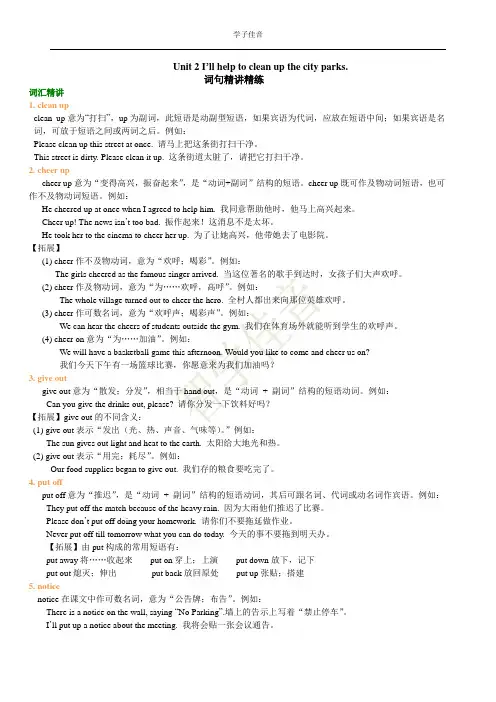
Unit 2 I’ll help to clean up the city parks.词句精讲精练词汇精讲1. clean upclean up意为“打扫”,up为副词,此短语是动副型短语,如果宾语为代词,应放在短语中间;如果宾语是名词,可放于短语之间或两词之后。
例如:Please clean up this street at once. 请马上把这条街打扫干净。
This street is dirty. Please clean it up. 这条街道太脏了,请把它打扫干净。
2. cheer upcheer up意为“变得高兴,振奋起来”,是“动词+副词”结构的短语。
cheer up既可作及物动词短语,也可作不及物动词短语。
例如:He cheered up at once when I agreed to help him. 我同意帮助他时,他马上高兴起来。
Cheer up! The news isn’t too bad. 振作起来!这消息不是太坏。
He took her to the cinema to cheer her up. 为了让她高兴,他带她去了电影院。
【拓展】(1) cheer作不及物动词,意为“欢呼;喝彩”。
例如:The girls cheered as the famous singer arrived. 当这位著名的歌手到达时,女孩子们大声欢呼。
(2) cheer作及物动词,意为“为……欢呼,高呼”。
例如:The whole village turned out to cheer the hero. 全村人都出来向那位英雄欢呼。
(3) cheer作可数名词,意为“欢呼声;喝彩声”。
例如:We can hear the cheers of students outside the gym. 我们在体育场外就能听到学生的欢呼声。
(4) cheer on意为“为……加油”。
例如:We will have a basketball game this afternoon. Would you like to come and cheer us on?我们今天下午有一场篮球比赛,你愿意来为我们加油吗?3. give outgive out意为“散发;分发”,相当于hand out,是“动词+ 副词”结构的短语动词。
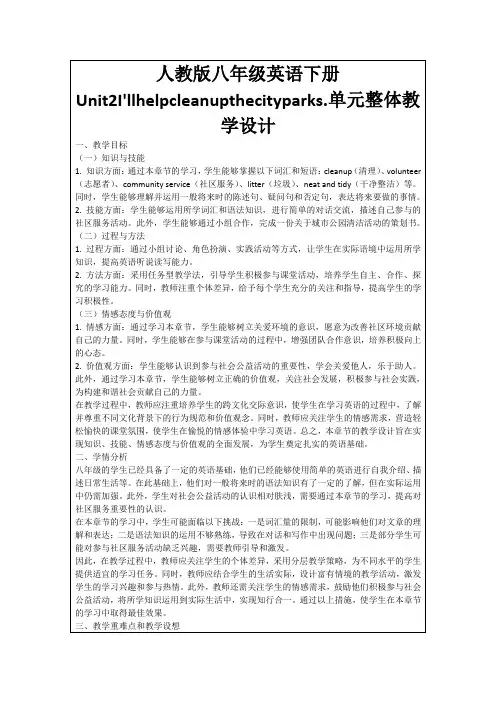
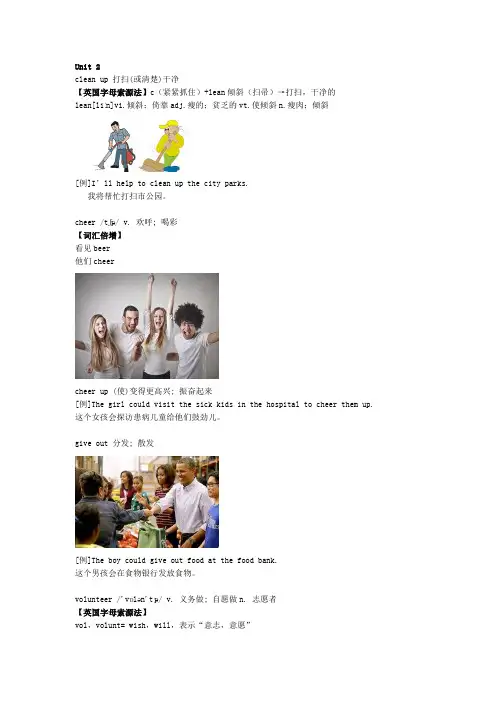
Unit 2clean up 打扫(或清楚)干净【英国字母索源法】c(紧紧抓住)+lean倾斜(扫帚)→打扫,干净的lean[liːn]vi.倾斜;倚靠adj.瘦的;贫乏的vt.使倾斜n.瘦肉;倾斜[例]I’ll help to clean up the city parks.我将帮忙打扫市公园。
cheer /tʃɪə/ v. 欢呼; 喝彩【词汇倍增】看见beer他们cheercheer up (使)变得更高兴; 振奋起来[例]The girl could visit the sick kids in the hospital to cheer them up. 这个女孩会探访患病儿童给他们鼓劲儿。
give out 分发; 散发[例]The boy could give out food at the food bank.这个男孩会在食物银行发放食物。
volunteer /'vɒlən'tɪə/ v. 义务做; 自愿做n. 志愿者【英国字母索源法】vol,volunt= wish,will,表示“意志,意愿”volunteer n 志愿者(volunt+eer人→意愿的人→志愿者)voluntary a 志愿的,自愿的(volunt+ary)[例]The girl could volunteer in an after-school study program to teach kids. 这个女孩会在一个课外学习项目中担任自愿者来教孩子。
come up with 想出; 提出(主意、计划、回答等)[例]We need to come up with a plan for the City Park Clean-UP Day.我们需要就市公园清扫日的活动做出计划。
put off 推迟[例]We should put off the meeting.我们得推迟会议。
sign /saɪn/ n. 标志; 信号[例]We could see signs.我们能看见标志。
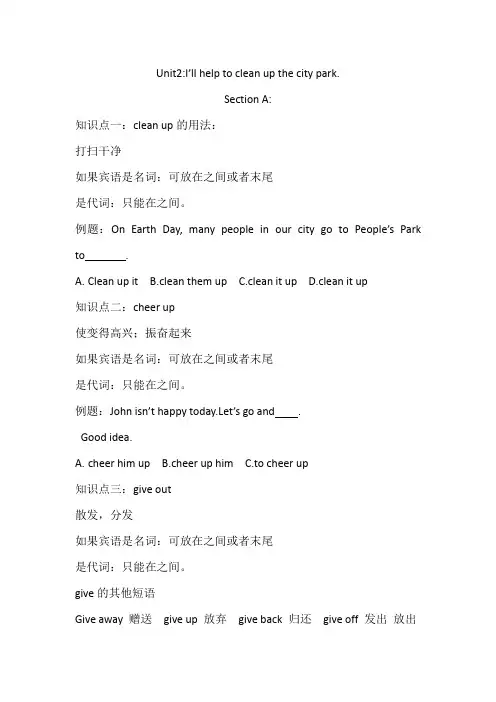
Unit2:I’ll help to clean up the city park.Section A:知识点一:clean up的用法:打扫干净如果宾语是名词:可放在之间或者末尾是代词:只能在之间。
例题:On Earth Day, many people in our city go to People’s Park to .A.Clean up itB.clean them upC.clean it upD.clean it up知识点二:cheer up使变得高兴;振奋起来如果宾语是名词:可放在之间或者末尾是代词:只能在之间。
例题:John isn’t happy today.Let’s go and .Good idea.A.cheer him upB.cheer up himC.to cheer up知识点三:give out散发,分发如果宾语是名词:可放在之间或者末尾是代词:只能在之间。
give的其他短语Give away 赠送give up 放弃give back 归还give off 发出放出Give sb sth给某人某物give in屈服例题:Could you please teach me how to red envelopes on WeChat? Sure. Let me show you.A.give outB.give backC.give way知识点四:put offput off意为“推迟”。
The concert was put off because of the heavy rain.演唱会因为大雨而被推迟了。
拓展:常见的put短语有:put off推迟;延迟穿上;put on展出;上演戴上put away收起来put out熄灭;扑灭put up with容忍put up搭建;建造张贴提升例4They the date of the meeting because of the bad weather.A.put offB.gave awayC.put onD.turn down知识点五used to的用法used to表示“过去常常;以前经常”,后跟动词原形,用来描述过去经常发生的动作或存在的状态。
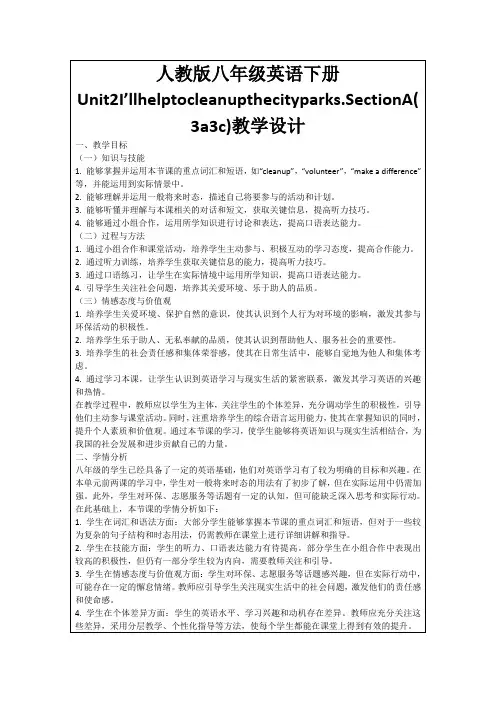
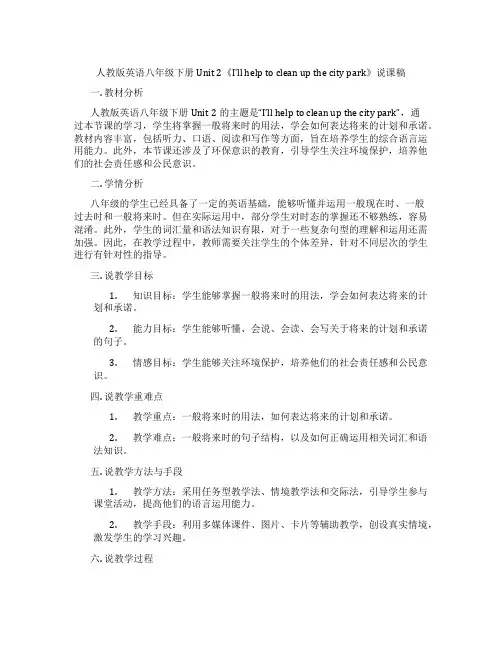
人教版英语八年级下册Unit 2《I’ll help to clean up the city park》说课稿一. 教材分析人教版英语八年级下册Unit 2的主题是“I’ll help to clean up the city park”,通过本节课的学习,学生将掌握一般将来时的用法,学会如何表达将来的计划和承诺。
教材内容丰富,包括听力、口语、阅读和写作等方面,旨在培养学生的综合语言运用能力。
此外,本节课还涉及了环保意识的教育,引导学生关注环境保护,培养他们的社会责任感和公民意识。
二. 学情分析八年级的学生已经具备了一定的英语基础,能够听懂并运用一般现在时、一般过去时和一般将来时。
但在实际运用中,部分学生对时态的掌握还不够熟练,容易混淆。
此外,学生的词汇量和语法知识有限,对于一些复杂句型的理解和运用还需加强。
因此,在教学过程中,教师需要关注学生的个体差异,针对不同层次的学生进行有针对性的指导。
三. 说教学目标1.知识目标:学生能够掌握一般将来时的用法,学会如何表达将来的计划和承诺。
2.能力目标:学生能够听懂、会说、会读、会写关于将来的计划和承诺的句子。
3.情感目标:学生能够关注环境保护,培养他们的社会责任感和公民意识。
四. 说教学重难点1.教学重点:一般将来时的用法,如何表达将来的计划和承诺。
2.教学难点:一般将来时的句子结构,以及如何正确运用相关词汇和语法知识。
五. 说教学方法与手段1.教学方法:采用任务型教学法、情境教学法和交际法,引导学生参与课堂活动,提高他们的语言运用能力。
2.教学手段:利用多媒体课件、图片、卡片等辅助教学,创设真实情境,激发学生的学习兴趣。
六. 说教学过程1.导入:通过展示城市公园的图片,引导学生谈论自己对公园的印象和感受,引出本节课的主题。
2.新课呈现:讲解一般将来时的用法,展示相关句子和例句,让学生感知和理解一般将来时的结构。
3.操练环节:通过听力练习、角色扮演、小组讨论等形式,让学生在实际语境中运用一般将来时。
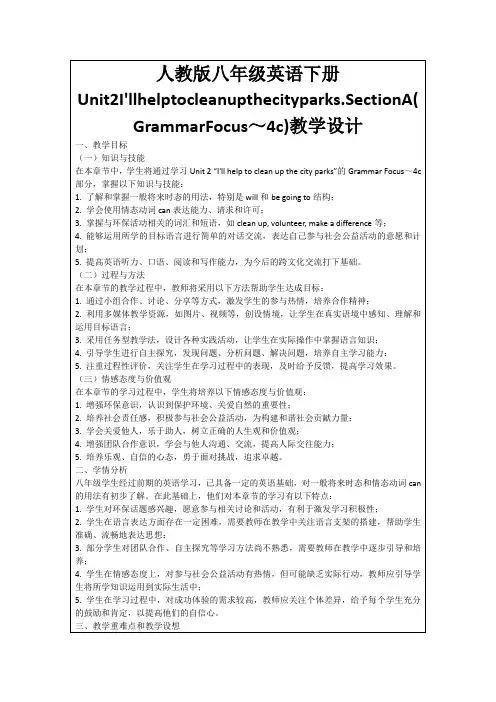
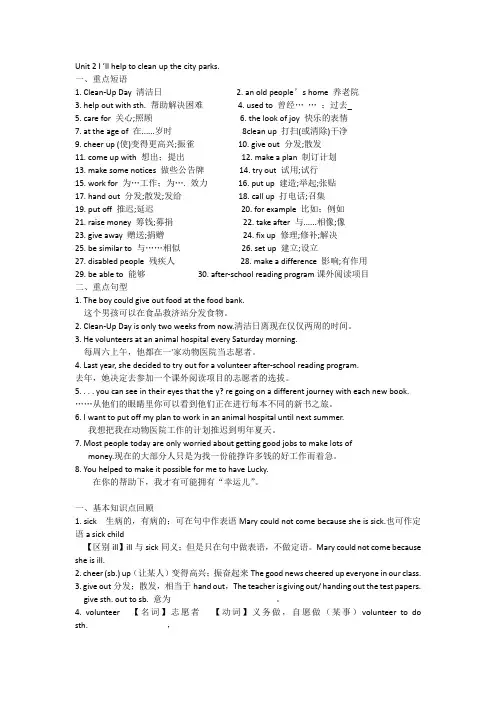
Unit 2 I ’ll help to clean up the city parks.一、重点短语1. Clean-Up Day 清洁日2. an old people’s home 养老院3. help out with sth. 帮助解决困难4. used to 曾经……;过去_5. care for 关心;照顾6. the look of joy 快乐的表情7. at the age of 在......岁时8clean up 打扫(或清除)干净9. cheer up (使)变得更高兴;振雀10. give out 分发;散发11. come up with 想出;提出12. make a plan 制订计划13. make some notices 做些公告牌14. try out 试用;试行15. work for 为…工作;为…. 效力16. put up 建造;举起;张贴17. hand out 分发;散发;发给18. call up 打电话;召集19. put off 推迟;延迟20. for example 比如;例如21. raise money 筹钱;募捐22. take after 与......相像;像23. give away 赠送;捐赠24. fix up 修理;修补;解决25. be similar to 与……相似26. set up 建立;设立27. disabled people 残疾人28. make a difference 影响;有作用29. be able to 能够30. after-school reading program课外阅读项目二、重点句型1. The boy could give out food at the food bank.这个男孩可以在食品救济站分发食物。
2. Clean-Up Day is only two weeks from now.清洁日离现在仅仅两周的时间。
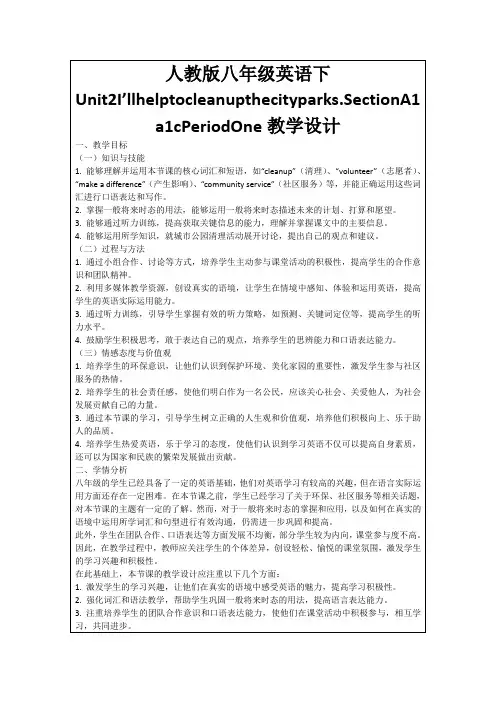
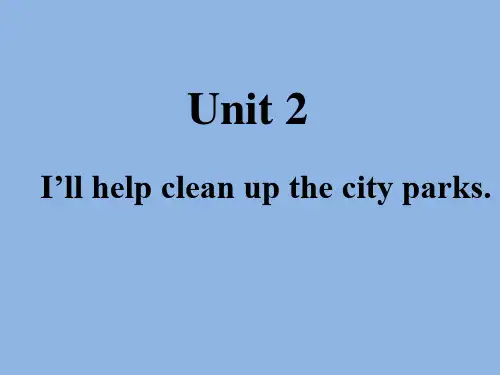
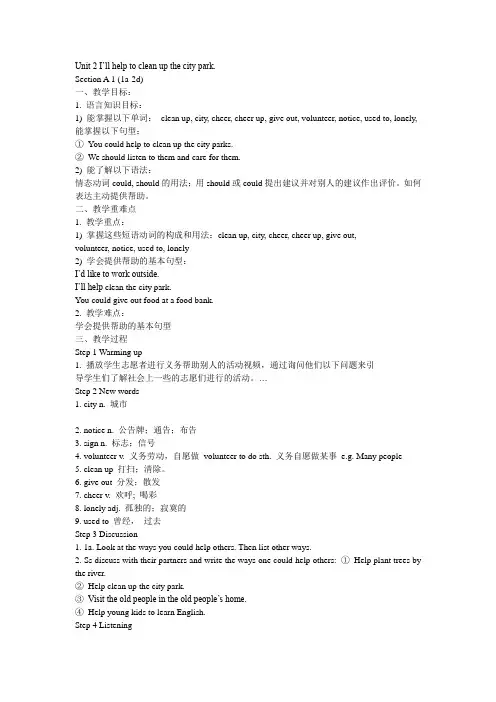
Unit 2 I’ll help to clean up the city park.Section A 1 (1a-2d)一、教学目标:1. 语言知识目标:1) 能掌握以下单词:clean up, city, cheer, cheer up, give out, volunteer, notice, used to, lonely, 能掌握以下句型:①You could help to clean up the city parks.②We should listen to them and care for them.2) 能了解以下语法:情态动词could, should的用法;用should或could提出建议并对别人的建议作出评价。
如何表达主动提供帮助。
二、教学重难点1. 教学重点:1) 掌握这些短语动词的构成和用法:clean up, city, cheer, cheer up, give out,volunteer, notice, used to, lonely2) 学会提供帮助的基本句型:I’d like to work outside.I’ll help clean the city park.You could give out food at a food bank.2. 教学难点:学会提供帮助的基本句型三、教学过程Step 1 Warming up1. 播放学生志愿者进行义务帮助别人的活动视频,通过询问他们以下问题来引导学生们了解社会上一些的志愿们进行的活动。
…Step 2 New words1. city n. 城市2. notice n. 公告牌;通告;布告3. sign n. 标志;信号4. volunteer v. 义务劳动,自愿做volunteer to do sth. 义务自愿做某事e.g. Many people5. clean up 打扫;清除。
6. give out 分发;散发7. cheer v. 欢呼; 喝彩8. lonely adj. 孤独的;寂寞的9. used to 曾经,过去Step 3 Discussion1. 1a. Look at the ways you could help others. Then list other ways.2. Ss discuss with their partners and write the ways one could help others: ①Help plant trees by the river.②Help clean up the city park.③Visit the old people in the old people’s home.④Help young kids to learn English.Step 4 Listening1. T: Tell Ss to read the sentences in the chart. Make sure they know the meaning ofthe sentence2. 1b. Play the recording for the Ss to listen and number the ways the boy and girl could help others.(Key: 3, 2, 4, 1)Step 5 Pair work1. Let Ss read the conversation in the picture.2. 1c. Use the information in the chart of 1b to make other conversations.A: I hope to work outside.B: You could help to clean up the city parks.……3. Let some pairs act out their conversations.Step 6 Listening1. 2a:T: A group of students are planning a City Park Clean-up Day. Listen and check (√) the things they are going to do to tell people about it.1. Look at the pictures in 2a. Discuss the things they are going to do.2. Play the recording for the Ss to listen and check the pictures.3. Play the recording again to check the answers.Answers: b, c, e2. 2b:1. Let Ss read the sentences below. Explain some main sentences for the Ss. Make sure they know what to do.2. Play the recording for the Ss to write the correct words in the blanks.1. We need to _____ ___ ____ a plan to tell people about the city park clean- up.2. Clean-up Day is only two weeks from now. We can’t ___ ___ making aplan.3. We could ___ ___ signs.4. Let’s make some notices, too. Then I’ll ____ them ____ after school.5. We could each ____ ___ 10 students and ask them to come.3. Play the recording again to check the answers.Answers: 1. come up with 2. put off 3. put up 4. hand, out 5. call up Step 7 Pair work1. 2c. Tell Ss to make a conversation using the information in 2a and 2b.2. Let one pair to read out their conversation first.e.g.Step 9 Language points1. They told me stories about the past and how things used to be.used to do sth. 过去常常做某事;表示过去习惯性、经常性的动作或状态,暗指现在已经不存在。
精选文档Unit2 I ’llhelp to clean up the city parksSection A1.I ’ll help to clean up the city parks 。
我将要帮助打城市公园。
【分析 1】 I ’ll=I will未来的构: will+dobe going to +dobe +doing(move/go/come/leave/fly表示⋯位移的) there be 的未来构: there will bethere is /are going to be【分析 2】 help v →helpful adj.1). help sb. (to) do sth. = help sb. with sth.帮助某人做某事。
2). help oneself( to)自用(食品等);随意吃···3). help sb. out 帮助某人战胜困,渡关、解决、达成工作。
4). with the help of在⋯⋯帮助下。
5).Can’ t help doing 不由自主做 ....练习题:()1.— Mary is so ________ — she comes to you whenever you ’re in trouble.A. usefulB. carefulC. thankfulD. helpful()2.The woman ___all of her money to charities____ the poor.A. gave off, to helpB. gave up, helpingC. gave away, to helpD. gave, helping()3.She can't help _________ the house because she's busy making a cake.A. cleaningB. to cleanC. cleanedD. being cleaned()4.While shopping, people sometimes can't help _________ into buying something they don't really need.A. to persuadeB. persuadingC. being persuadedD. be persuaded()5 "Help___to some chicken!"she said to my guests.A. youB. yoursC. yourselvesD. yourself【分析 3】 clean up 把⋯⋯打干【up 短】cheer up (使)抖擞起来; give up 放弃clean up 消除fix up 维修set up 成立put up 起get up 起床stay up (late) 熬夜come up with 想出;提出pick up 起grow up 成wake up 醒来make up 造cut up 切碎turn up高大(声音)look up call up 招集hurry up快点儿,赶忙练习题:1. It ’s your turn ____________up the kitchen.(clean)() 2. Your bedroom is too dirty, please _____.A. clean it upB. clean up itC. set it up() 3. If everyone pours less polluted water into Dianchi Lake, it will be _____.A. deeper and deeperB. cleaner and cleanerC. dirtier and dirtierD. wider and wider( )4 . —Diaoyu Island belongs to China.— Surely it does! We Chinese will never it up.A. cutB. fixC. giveD. set() 5. He looks sad .Let ’s ___ him___.A. cheer , upB. put, upC. set upD. call, up( ) 6. — It's too hard for me to be a trailwalker. — Never ________. Believe in yourself!A. put upB. give upC. hurry upD. look up2. The girl could visit the sick kids in the hospital to cheer them up. 女孩能够去医院探望患病的孩子们,让他们抖擞起来。
人教版初二英语下册Unit2I'llhelptocleanupthecityparks【课本内容剖析】Section A1.You could help to clean up the city parks. (P. 9)(1) ① help sb. with sth. 帮助某人某事翻译:你能在家庭作业方面帮助我吗?_______________________________① help sb. (to) do sth. 帮助某人做某事翻译:他常常帮助他妈妈做家务。
___________________________________(2)clean up意为“排除干净”翻译:Nancy, please clean up your room. _______________________________2.The girl could visit the sick kids in the hospital to cheer them up. (P. 9) cheer up意为“使高兴, 使振作、振奋”,代词用作宾语时,要当在cheer和up之间。
翻译:Cheer up! Everything will be OK. __________________________________3.The boy could give out food at the food bank. (P. 9)give out意为“分发、散发”,相当于hand out。
翻译:这有一些书。
请把它们分发给同砚们。
______________________________________________________________4.The girl could volunteer in an after-school study program to teach kids. (P. 9) volunteer用作动词,表示“义务做、自愿做”,后接不定式作宾语,volunteer to do sth.“志愿做某事”;作名词,表示“志愿者”,为可数名词。
Unit 2 I’ll help to clean up the city parksSection B 2a-2e 教学设计教学分析本节课是八年级下册第2单元Section B2a-2e 阅读板块的教学内容。
该部分阅读材料是Ben Smith写给Miss Li 一封感谢信。
Ben Smith是一名残疾人,手脚都不能正常活动。
他的一位朋友帮他与“动物助手”组织联系,试图找到一条狗作为助手。
经过六个月的训练,他把狗助手Lucky带回了家。
Lucky很聪明,能听懂Ben Smith的命令,给了主人Ben Smith 很多帮助和快乐。
这一切都要感谢Miss Li , 她捐钱给“动物助手”组织,帮助Ben Smith得到Lucky,改变了生活。
阅读文本突出了本单元的核心话题Volunteering and Charity. 对于文本内容的人文内涵,教师要予以深刻挖掘,以期达到英语课程工具性和人文性的统一。
对于本篇阅读材料,教师要引导学生通过获取狗助手给主人带来的喜悦和生活的改变等信息,深刻理解Miss Li对Ben Smith的帮助与友爱,从而唤起学生对残疾人的关爱意识,培养学生对社会、对他人的爱心。
学情分析书信是学生比较熟悉的一种文体形式。
学生在七年级已经接触过英文书信,而且英文书信和汉语书信在格式上有很大相似之处。
因此,学生掌握英文书信并不难。
教师要带领学生回顾英文书信的格式,激活并强化学生的形式图式,为阅读文本做好准备。
此过程中,学生需要弄清楚阅读文本是Ben Smith写给Miss Li 的一封信,这是正确理解文本信息、了解作者写作意图的前提。
整体设计教学目标认知与技能:1.在语境中学会如下单词:blind, deaf, disabled, letter, difficulty, normal, kindness.2.运用正确的阅读策略阅读文本,理解其内容明白作者的写作意图。
3.领悟猜测词义的方法并运用这一阅读策略更好地理解文本。
4.通过开展小组活动,在阅读的基础上进行相关语言输出训练,提高语言表达能力。
情感态度与价值观:1.在阅读过程中唤起对残疾人的关爱意识,树立同情心;2.认识动物和人类的伙伴关系,和动物和谐相处并更加关爱动物。
【教学重点】:领会作者的写作意图【教学难点]】:着重训练表达能力。
【课时安排】: 1 课时【课前准备】:课本、多媒体课件、录音机。
【教学方法】:情景交学法、小组活动发、自主学习和合作学习相结合。
教学设计教学过程设计1.pre-reading(1)Watch a videoT: Who is keeping a dog as a pet ?Ss:some people. Student 1 answers that my family is keeping a little dog as a pet , and I like it very much.T: What do you think of your dog ? The student answers. 之后全体学生观看一段短视频,内容为狗助手在家里照顾一位小男孩。
观看视频后,T: What do you think of the dog ? The students answer. After that , the teacher gives a question. What other people do you think dogs can help ?(设计意图:学生看短视频,生动有趣,既激活了学生有关狗助手的相关图式,又迅速地吸引了学生的注意力。
观看后,教师通过提问引发学生思考,为下一环节学习做好了铺垫。
)(2)Learn the new words结合视频让学生在语境中学习A dog helper is a special trained dog.It can understand orders.接着,教师引申,带领学生学习an animal helper,让学生说出:An animal helper is a special trained animal.教师再次结合视频提问:T: What other people do you think dogs can help ? Next,the teacher shows another group of TTP pictures,在语境中学习blind, deaf, disabled. A dog helper can help disabled people.(设计意图:脱离语境的词汇教学只能是词汇的学习停留在识记层面,要掌握目标词汇必须经历理解和运用两个阶段。
读前的词汇教学应创设语境,并聚焦于话题,通过语境学习单词,能够加深对目标词汇的理解,增加学生的语言输入。
聚焦话题的词汇学习能补充学生的语言图式,为学生阅读扫清障碍,降低学生的阅读焦虑。
)(3)Learn about the letter教师通过幻灯片出示教材2b中书信的图片,同时指出这是一封书信并提出如下问题:①When we write an English letter,what do we have to write at the beginning ? (Salutation)②What do we have to write at the end ? (Closing and signature.)③What is the part after the salutation ? (Body)学生回顾书信格式后,教师提出问题让学生思考,引出下一环节。
师生对话如下:T:Who wrote the letter ?Ss: Ben Smith.T: Who did Ben Smith write the letter to ?Ss: Miss LiT: Why did Ben Smith write the letter to Miss Li ?(设计意图:通过观看图片和知识回顾,学生认清文本的体裁,激活并强化已有图式。
通过师生问答,学生根据书信理清任务关系,为准确理解文本内容,了解作者写作意图做好了铺垫。
)(4)Predict.教师通过插图提出问题,引导学生通过读图对文本内容展开预测。
Who do you think the man is ?What’s wrong with him ?Do you think the dog can help him ?Who do you think the woman is ?(设计意图:教材插图是预测文本内容的重要线索。
有效的阅读预测不是对阅读文本毫无根据的凭空想象,而是建立在一定线索之上的合理推测,这样的预测才能有助于更好地理解文本内容。
学生已经了解到这是Ben Smith写给Miss Li的一封信,从而推测出插图的男士是Ben Smith. 这位女士是谁?她不是Miss Li,带着这个疑惑,学生走进阅读,并且有了更强的阅读期待。
)2.While-reading(1). 学生快速阅读文本,然后将段落大意与序号连线。
Read quickly and match the two columns.Para 1 How does Lucky help Ben Smith ?Pare 2 Ben thanks Miss Li for giving money to Animal HelpersPara 3 What are Ben’s problems ?Para 4 Ben thanks miss li again.之后教师让学生回答如下问题:Why does Ben Smith write the letter ?学生回答:He wants to say thanks to Miss Li. 教师引导学生认识到:This is a thank-you letter.(设计意图:通过略读理解文章大意是学生应具备的一项重要阅读策略。
略读的目的是让学生理清文本脉络,确定文本大意,从整体上把握作者的写作意图。
学生完成连线题,掌握各段大意;通过回答问题,从整体上认知文本。
)(2)Read and fulfill tasks①教师组织学生阅读第一段并完成逻辑线索图:Why does Ben Smith want to thank Miss Li ?Miss Li gave money to Animal HelpersShe helped to make it possible for Ben to have LuckyLucky makes a big difference in Ben’s life.②细读文本第二段并完成填空任务:1.Ben is disabled person.He can’t use his arms or legs well2.Normal things like answering the telephone, opening and closing doors, or carrying things are difficult for Ben.3.A friend helped Ben out.She talked to Animal Helpers, and Ben was excited about the ideas of having a dog.(划线部分为要求学生填写的内容)。
教师呈现文中的句子:Most people would never think about this, but many people have these difficulties. 引导学生猜测difficulty的词义。
师生对话如下:T:Which word is difficulty similar to ?Ss: DifficultT: What part of speech do you think it is ?Ss: A noun.T: what do you think it is a noun ?Ss: It is after “these”. And it ends with “es”.T: Then can you guess its meaning ?Can you tell me what these difficulties refer to ?Ss: “Blind or deaf” and “can’t walk or use hands easily”③细读第三段完成改错任务:1.Ben trained with a dog for three months at Animal Helpers before he brought him home2.Ben feels very lucky to his dog, so he calls him Lucky3.Ben thinks he’s only able to have the dog because of Miss Li’s help4.Lucky can understand few English words.5.Lucky can not understand Ben when he gives him orders.④细读第四段:回答以下问题:T:What does Ben think of Lucky ?For what does Ben Smith thank Miss Li again ?学生回答第二个问题后,教师追问:Does Ben Smith thank Miss Li twice for the same reason ? 引导学生理解giving money和changing my life .两个事件之间的逻辑关系。